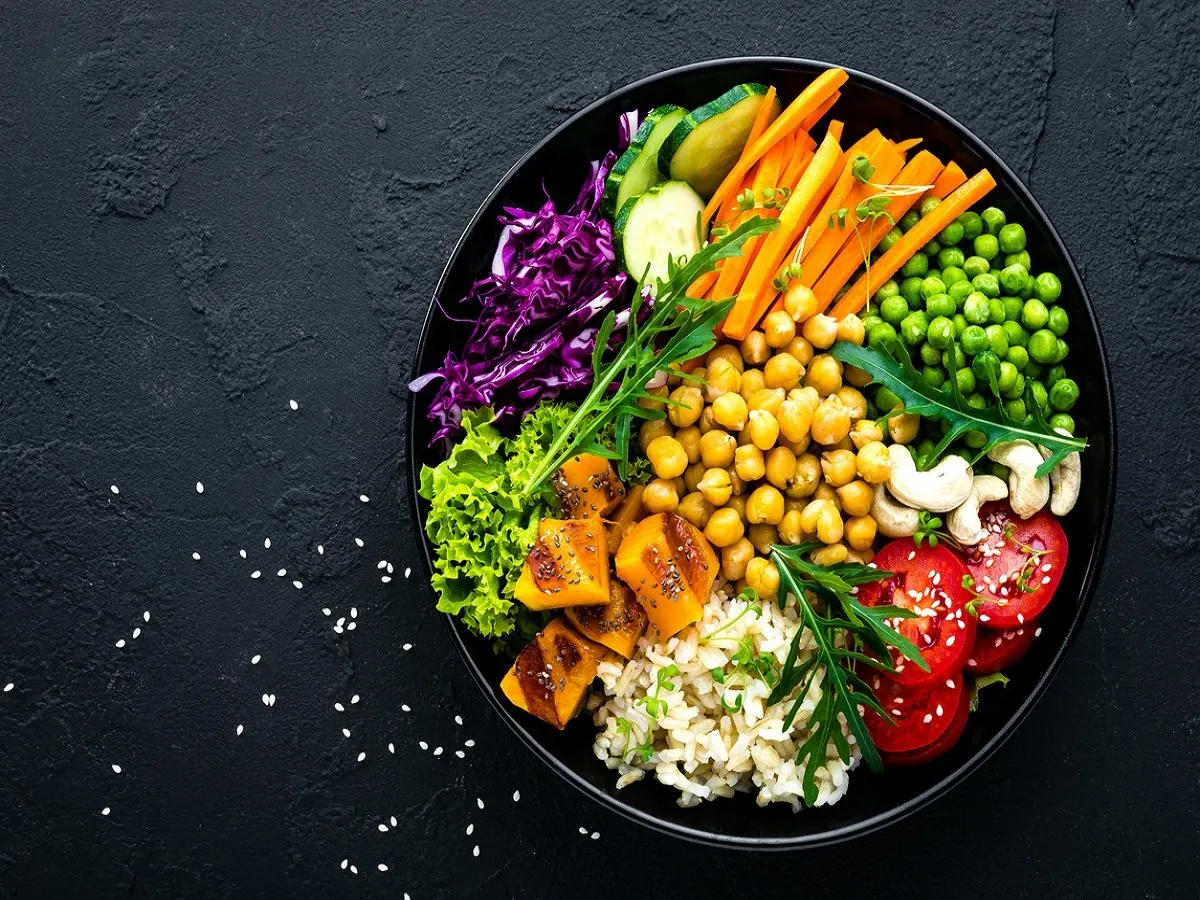“Healthy eating” is a term that has a number of interpretations, not because no one can give a clear definition of this process, but because it’s extremely individual. It seems that everyone, from healthcare professionals to your colleagues and family members, has their own opinion on how to eat healthily.
In addition to that, the articles on the Internet might be confusing with their contradictory, and often unfounded, suggestions and rules. All this complicates our desire to eat healthy, leaving us with a number of questions, such as: “So where is the truth?”
The truth is that healthy eating should be neither complicated nor radical. Strict diets, that either allow or prohibit the consumption of certain foods, are not a magic pill of health and slimness, but only harm our metabolism and psycho-emotional state. Eating while enjoying the food we love is quite possible and, moreover, it’s necessary.
After all, food is meant to be enjoyed, not feared, counted, weighed, and tracked. Remember, the process of eating begins with your tongue, or rather with the receptors on it. These receptors are connected to the pleasure center in our brain.
In our article, we will talk about healthy eating, not as a strict rule or diet that should be followed from day to day. Instead, we will give you the knowledge of how to eat so that your body looks healthy and full of energy, while your emotional health and immunity remain strong.
Individual Nutrition Plate Guide For Every Day
Imagine you are an office worker with a standard work schedule (Mon-Fri). Your work is 4 miles from home. Every day you use public transportation to get to the office. You have a gym subscription and go there every Monday, Wednesday, and Friday. This Thursday you overslept and used your car to get to work on time. This has reduced your average motor activity compared to the days when you use public transport.
On Saturday, you are surprisingly active, waking up at 6 am for a morning jog. You like jogging on Saturday. Your average training lasts for one hour and results in 6 miles. Then you have a number of household chores. In other words, Saturday is a super active day in your weekly schedule. But on Sunday you like to sleep till 9, and spend the whole day relaxing, not in a hurry, at most you arrange a meeting with friends in the nearest cafe. In other words, your physical activity, like all activity in general, is minimal.
As you can see, no matter how routine our lives may seem, every day is different from each other, and the amount of energy we spend every day is also different.
If we consider our body as an engine, then food will serve as fuel for this engine. High-quality fuel ensures highly efficient engine operation, and fuel with impurities not only degrades the quality of engine operation but also accelerates the depreciation of the entire vehicle. The same goes for our bodies. In order for our body to function properly, the food that comes to it must contain all necessary nutrients.
It is also worth noting that your body’s needs change daily, so you need to replenish your body in different ways, according to these requirements. Eating the same thing day after day is like filling the tank of your car with the same amount of fuel, regardless of what the trip will be: short or long. This whole approach just won’t make sense. That is why when shaping your diet you need to take as a basis the needs of the body, and not tie yourself to certain patterns.
Learning how to prepare individual nutrition plates for every day is an easy way to follow the right principles at the right time. In our article, we distinguish three types of nutrition plates for the different needs of your body. However, in practice, except in a few cases, most of us need only two types of plates to work and maintain physical activity in a good shape. The main thing is to use them at the right time and day of the week.
Nutrition Plate Preparation
A nutrition plate preparation consists of four parts, which in turn correspond to four main components.
- Recovery = High-Quality Proteins
- Fuel = Slow-Releasing Carbohydrates
- Protection = Vegetables, fruits, and healthy fats
- Restoration of water balance = Liquids
Definitely, the preparation of any plate should begin with recovery, and these are proteins. Then we add fuel in the form of carbohydrates with a low glycemic index, the amount of which, in turn, depends on the loads during training and your personal goals.
The third component of the nutrition plate is protection provided by the micronutrients found in vegetables, fruits, and healthy fats. The last and final element is the restoration of water balance. The need for fluid usually increases before and after training to prepare the body for stress and after fluid loss. It’s important to drink fluids 15-20 minutes before your workout so you won’t stimulate your kidneys during your workout.
A vast amount of products can be used to form a plate (in general, variety in terms of nutrition is great!). First and foremost, it’s important to know which sources of recovery, fuel, and protection work best for you based on your possible dietary restrictions (for example, if you’re vegetarian or have a gluten intolerance, etc.). And, of course, whatever these sources are, first of all, they should bring you pleasure.
Step 1: Recovery Products ( Proteins)
Proteins are macronutrients that are necessary for the formation, strengthening, and restoration of muscles, bones, skin, hair, and vital organs, and are also the main component of enzymes, hormones, and antibodies. Proteins also play an additional role in energy production, although their role in comparison with fats and carbohydrates is much smaller here.
There are 20 different amino acids that make up each molecule of protein, and these are split into 2 categories: Non-Essential Amino Acids and Essential Amino Acids (EAAs)
- Non-Essential Amino Acids – produced naturally by the body
- Essential Amino Acids – not produced naturally by the body and must be consumed through food or supplementation
In turn, Essential Amino Acids are divided into two categories: plant and animal-based proteins.
The main difference between animal and plant proteins is their amino acid profile. Most animal proteins are complete proteins, meaning they contain all 9 of the essential amino acids (EAAs). Most plant proteins are considered incomplete proteins, meaning they are missing at least one essential amino acid. However, eating multiple plant proteins together can create the effect of complete proteins.
Complete proteins are meat, fish, seafood, eggs, milk, cheese, yogurt, quinoa, buckwheat, and soybeans.
Incomplete proteins are black beans, beans, chickpeas, lentils, edamame, buckwheat, quinoa, tempeh, tofu, brown rice, etc.
Remember that the size of one portion of the necessary protein for the body is equal to the size of your palm (excluding fingers).
Step 2: Products For Refueling (Carbohydrates)
One of the most important parameters that should be taken into account when choosing carbohydrate products is the glycemic index. The glycemic index shows how quickly foods are broken down and converted into glucose in the blood. Mostly it is recommended to eat foods with a low GI level so that energy is released gradually. This means that you should choose whole-grain versions of your favorite products – rice, pasta, and bread.
Sources of carbohydrates include cereals (oatmeal, muesli, flakes and bran, corn flakes, granola); bread (preferably whole grain), legumes (wild rice, bulgur, buckwheat, quinoa, lentils, barley, couscous, basmati rice, etc.), pasta, noodles, potatoes, fruits and berries, vegetables. It should be noted that almost all vegetables, with the exception of starchy foods, have a low glycemic index.
Remember, the size of one portion of carbohydrates needed by the body is equal to one of your handfuls.
Step three: Products For Protection (vegetables, fruits, and healthy fats)
The third step in shaping your plate is adding protective products. Periodically, your need for vegetables will increase (for example, in winter). However, as a rule, eat two different types of vegetables at every meal to increase your micronutrient intake.
Please note that we are talking about non-starchy vegetables. Potatoes or sweet potatoes are starchy vegetables, so they are high in carbohydrates. In this case, they are an exception to the list of vegetables. At the same time, we include avocado in this list, even though it is not a vegetable.
Fruits and berries can be eaten for breakfast or as a snack, as they contain a large number of antioxidants and dietary fiber. It is recommended to include more vegetables than fruits in your meal plan because vegetables contain less sugar.
Remember, the size of one portion of vegetables necessary for the body is equal to two of your handfuls. The size of one portion of fruit = one handful. The size of one serving of healthy fats = 1 thumb.
Weight and Portion Ratio
You may be wondering: Is the serving size the same for people of different genders, heights, and weights? Obviously, the answer will be positive. The bigger and heavier a person is, the heavier their body weight will be and their need for carbohydrates, proteins, and fluids will be bigger correspondingly.
Thus, knowing the standard sizes of a single portion, you can adjust this volume according to your body weight. For simplicity, we will use two sizes of portions: standard and large. The limit of a standard portion will pass at the mark of 165 lbs. If your weight is equal to or less than 165 lbs – use a standard portion, if more – use an increased portion (1.5 of the standard portion).
Try, experiment, and remember that your main goal is to get up from the table with the feeling that you have eaten enough, not hungry or overeating. Learn to listen to your body!
Nutrition Plates Types
There are two types of nutrition plates that a person can use as part of their energy plan: a refueling plate (fuel plate) and a recovery plate. Separately, you can single out another category for athletes, where nutrition should be adjusted according to the type of sport and the goals of the athletes.
Fuel plate
You probably already understand that when it comes to training, the most important requirement is refueling before and recovering after it. Fueling gives us enough energy to get through the exercise, while recovery helps the muscles adapt and restore glycogen stores. In addition, a fuel plate is a necessary tool for maintaining energy levels throughout the working day.
The fuel plate, which ensures our efficiency, consists of three parts:
- One serving for recovery (protein)
- One portion for refueling (carbs)
- One serving for protection (vegetables/fruits and healthy fats)
It should be noted that when using the fuel plate, it is important to drink the liquid. In addition, the need for water increases before and after training.
An example of a fuel plate:
1 portion of turkey fillet boiled/baked in the oven / cooked on the grill; one portion of buckwheat; tomato and cucumber, drizzled with olive oil.
Recovery plate
The recovery plate includes:
- One and a half servings for recovery (proteins)
- One and a half servings for protection (vegetables)
- One serving of fat
An example of a recovery plate:
One and a half servings of fresh salmon, one and a half servings of cucumber, pepper, tomato, and avocado dressed with olive oil.
It is worth remembering that each of us has a different work schedule, but for most people, it will be correct to use a recovery plate at the end of the day, when the body is sufficiently fueled, and the energy is needed less (for example, there is no training after work). The need for liquid consumption also decreases, so you can safely avoid the last cup of tea at night.
Snacks
Is it good to have a snack between meals? Definitely, yes! If we consider that eating is the foundation, then snacks are a support structure to keep us in shape throughout the day. Snacks are necessary for the constant recovery of our muscles.
Remember, snacks are supposed to satisfy our hunger, but they should not replace a full meal, cause a spike in blood glucose or add extra pounds in the form of fat on the buttocks or belly.
There are three types of snacks, but only two are enough for the average person (not a professional athlete).
Types of snacks:
- Protein-based snack
- Snack based on protein + carbohydrates
- Carbohydrate-based snack
Let’s look at each of these types in more detail.
Protein-based snack (recovery snack)
- Supports muscle growth and recovery (including at night after intense training)
- Helps to meet the increased need for proteins as part of a training program
- Increases protein intake during energy deficits (when you’re trying to reduce body fat)
- It is used as a daytime snack to get rid of the feeling of hunger before dinner
Examples of this type of snack include seeds, nuts, low-fat Greek yogurt, edamame, or a protein shake.
Snack based on protein + carbohydrates (snack before and after training)
- Snack before training: 1-2 hours before training
- Post-workout snack: quick refueling and muscle recovery before your next meal.
Examples of this type of snack include a salmon sandwich, low-fat Greek or natural yogurt with a banana and nuts.
Carbohydrate-based snack (snack during the competition)
- Raises the level of carbohydrates before, during, and after a sporting event
- Provides the body with carbohydrates that are easily absorbed by the body (high GI carbohydrates) before and during the competition.
Examples of this type of snack: homemade oatmeal, honey, and dried fruit bar, banana bread, cereal bar, and ripe bananas.
Liquids
So, with regard to food, we have already figured it out, but the question remains: what and in what quantity to drink?
First of all, avoid sugar! Give up all kinds of sweet highly carbonated drinks, try not to use fruit juices and all kinds of sweeteners for cocktails and coffee.
It is best to eat fruits and vegetables in their whole form, as this way your body has a better chance of getting all the vitamins and minerals it needs from this product, as well as reducing the level of sugar consumed. The only exception is if you are intentionally increasing your carbohydrate intake from vegetables and fruits. In this case, you can drink a juice rich in antioxidants to strengthen immunity, or a fruit and milk cocktail to recover after a grueling workout.
The temperature and taste of the drink should also be taken into account. You have probably noticed that restaurants have a habit of serving water with ice, pieces of lemon, cucumber, rosemary, etc. Such water tastes much nicer than ordinary water from under the cooler in your office or home. When preparing a drink for yourself, do not forget to experiment. Turn on your creativity: take a beautiful glass, add ice, and a slice of lemon. Do not forget that any meal should be enjoyable!
Final Words
Eating healthy is simple. You don’t need any special diet for staying healthy and in shape; moreover, you can eat anything you want, just mind your plans for the day and select what you need most: recovery or fuel plate + liquids.
Hope our guide will help you to reach your nutrition goals. Eat well and stay healthy!







